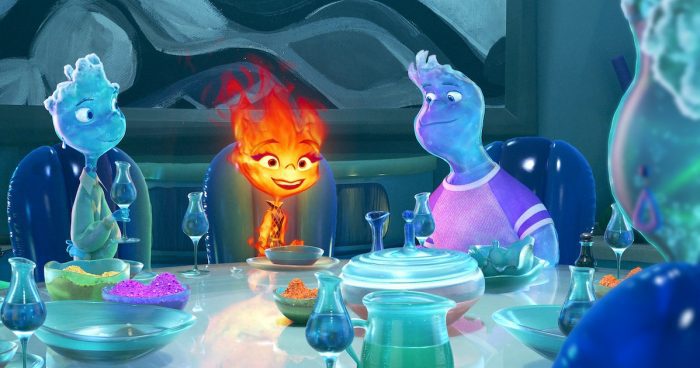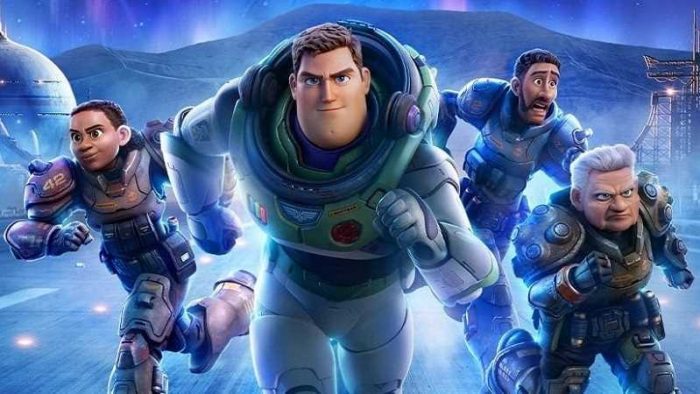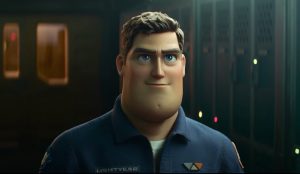Reviewed by Jeffrey Sanzel
Elemental marks Pixar’s twenty-seventh animated feature. The most successful include the four Toy Story movies, Finding Nemo, Monsters, Inc., Cars and its sequels, WALL-E, Coco, Inside Out, and most recently, the unusual but fascinating Lightyear.
Director Peter Sohn pitched the idea for Elemental to Pixar after the release of The Good Dinosaur (2015). The son of immigrants, Sohn took inspiration from his childhood in the culturally diverse 1970s New York City, as well as romantic films such as Guess Who’s Coming to Dinner (1967), Moonstruck (1987), and Amélie (2001).
In a 2022 Variety interview, Sohn explained: “Maybe it’s because when I was a kid, I really didn’t appreciate or understand what it meant to be an immigrant, to come to the U.S., and all the hard work that [my parents] did to give my brother and me our lives […] On the other side, I married someone that wasn’t Korean, and there was a lot of culture clash with that in my world. And that brought to me to this idea of finding opposites. And the question of what if fire fell in love with water came.”
While perhaps not the most brilliant of the studio’s output (Toy Story, Coco), Elemental is a surprisingly clever, heartfelt story of opposites uniting. Set in a world of the elements—fire, water, earth, and air—daughter of Fireland immigrants, Ember Lumen, becomes involved with water element Wade Ripple, an easily flustered water inspector.
After Ember causes a plumbing accident in her father’s convenience store, The Fireplace, Wade appears in the soaked basement. An adventure ensues throughout Element City, with the unlikely pair joining forces to solve the immediate situation, then becoming involved in solving a greater problem within the community. Ember learns to curtail her destructive temper, but equally as important, she learns to speak her truth.
The film tackles multiple issues with style and finesse. The story’s foundation focuses on honoring one’s culture and the sacrifices often entailed. But it also celebrates the individual’s pursuit of personal happiness. Much of the screenplay (by John Hoberg, Kat Likkel, and Brenda Hsueh) addresses bias and hostility regarding the treatment of immigrants. Boldly shown in the prologue, Ember’s parents, newly arrived, are shut out of living quarters controlled by people of earth, air, and water. There is also the issue of the burden often placed on first-generation children to continue what their parents have started. The film smartly addresses this with great sensitivity without resorting to preaching.
Ultimately, Elemental is a traditional rom-com, with all the hurdles and pitfalls, and even a dating montage—but an entirely unique setting. (This more adult slant in the film lost some of the younger audience members who became restless as the film progressed.) However, the gloriously exquisite animation is a joy, the anthropomorphizing creating a perfect blending of human and “other.” The visual puns are matched by the cleverly ever-present, sometimes subtle—and often not so subtle—wordplay.
While not as starry as many of the Pixar catalogue, the vocal talent is first-rate. Leah Lewis embodies Ember’s struggle with wry wit and genuine charm. Mamoudou Athie presents Wade’s growth from mildly neurotic underachiever to hero, never losing his kind center. Ronnie del Carmen and Shila Vosough Ommi play Ember’s parents with the right blend of love and whimsy, arcing from frustration to acceptance.
Catherine O’Hara is delightful as Wade’s mother, Brook Ripple, featured in a hilarious dinner party where Ember is both welcomed and mildly embarrassed by the overly and overtly emotional Wade clan. This scene leads to Ember’s pointed comment on Wade’s rich-kid-follow-your-heart family, said with vexation tinged with a hint of jealousy. In what amounts to a cameo, Wendi McLendon-Covey’s Gale Cumulus, Wade’s employer, makes a bigger-than-life impression in an appropriately grand performance.
Starting with the premise “Elements don’t mix,” touching on the bonds and struggles of parents and children, building to a love that crosses boundaries, and culminating with a message of acceptance and love, Elemental may never become a classic, but it sits easily—and proudly—in the Pixar family.
Rated PG, the film is now playing in local theaters.
*A bonus, “Carl’s Date,” precedes the feature. The Up short marks one of the final works of Ed Asner, who passed away in 2021. The sweet piece shows a gentler side of the curmudgeonly Carl as he prepares for a date while being advised by the “talking” dog, Dug. It is an ideal complement to the romantic elements of Elemental.








